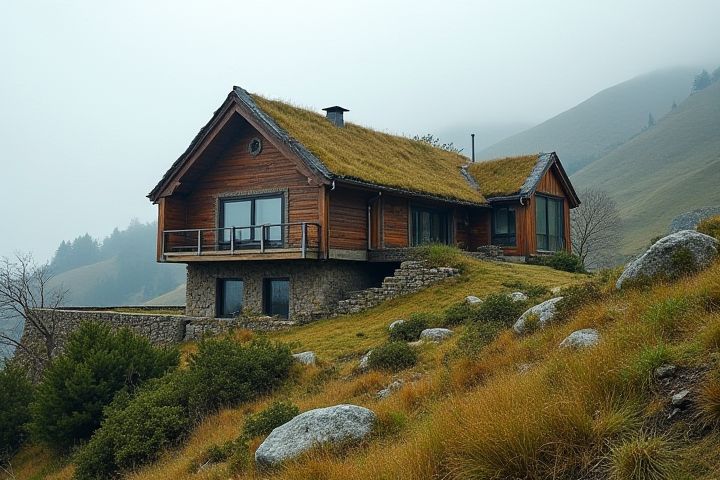
Building a house on a hillside requires careful consideration of factors like soil stability, drainage, and orientation to maximize views and natural light. Look for a location with a gradual slope to minimize excavation and foundation costs, and prioritize areas with well-drained soil to prevent water accumulation. Assess the sun's path to optimize passive heating and cooling, ensuring your design takes advantage of solar gain in winter while providing shade in summer. Accessibility is essential; consider the placement of driveways and pathways for safety and convenience. Additionally, local zoning regulations and environmental impact assessments should guide your site selection for compliance and sustainability.
Where To Build A House On A Hillside
Soil stability
When selecting a location to build a house on a hillside, prioritize areas with stable soil composition, as it plays a critical role in preventing landslides and erosion. Look for sites with well-drained, cohesive soils such as clay or silt, which can provide the necessary support for your foundation. Conduct soil tests to assess the load-bearing capacity and drainage characteristics; this will help identify any potential risks linked to soil instability. Furthermore, positioning your house away from steep slopes and adhering to proper grading techniques can significantly enhance your property's safety and longevity.
Drainage systems
When building a house on a hillside, it's crucial to assess the slope and soil type to ensure effective drainage systems are in place. Incorporating a French drain or trench drain can help redirect water away from the foundation, preventing erosion and water damage. You may consider installing rain gardens or permeable pavements to manage runoff and enhance water absorption in the landscape. Proper grading around the home will also direct rainwater away from the structure, providing added protection against potential flooding issues.
Zoning laws
When considering building a house on a hillside, it's essential to research local zoning laws, which can vary significantly by region. Look for specific regulations concerning slope stability, building codes for seismic activity, and restrictions on height and design, as many hillside areas have unique topographical challenges. Ensure your location is within the designated residential zoning district, typically outlined in local planning documents, which may include setbacks and land-use restrictions. Engaging with local planning authorities will provide clarity on permits and any environmental assessments required before construction begins.
Foundation type
When constructing a house on a hillside, selecting the appropriate foundation type is crucial for stability and safety. A concrete pier foundation is often ideal as it elevates the structure above the ground, minimizing soil erosion and allowing water drainage. Alternatively, a concrete slab foundation can be effective on stable, level sections but may require additional reinforcement in sloped areas. Assessing soil conditions and local zoning regulations is essential to determine the best foundation approach for your hillside property.
Accessibility
When selecting a location to build a house on a hillside, prioritize areas with easy accessibility to main roads, which typically should be within 500 feet to ensure smooth transportation. Consider the slope of the land; a gradient of less than 15% is ideal for construction while minimizing erosion risk. Also, assess proximity to essential services, like schools and grocery stores, aiming for a distance of no more than 2 miles to ensure convenience. Ensuring ample access for emergency vehicles and construction equipment is vital; a width of at least 12 feet for your driveway will suffice for safety and practicality.
Erosion control
When selecting a location to build a house on a hillside, prioritize areas with natural drainage to minimize water accumulation, which can exacerbate erosion. Research the soil composition; clay soils often retain moisture, increasing erosion risk, while sandy soils generally offer better drainage. Implementing retaining walls or terracing can significantly enhance stability and control runoff, preserving the integrity of your foundation. Planting native vegetation with deep roots can also help bind the soil, reducing erosion while promoting biodiversity in your immediate surroundings.
Utilities access
When choosing a location to build your house on a hillside, prioritize proximity to essential utilities such as electricity, water, and sewage systems. Assess the accessibility of utility lines within a reasonable distance, as this will significantly reduce installation costs and ensure reliable service. Investigate local zoning regulations to confirm that your chosen site complies with utility easements and other requirements. It's also advisable to consult with utility providers to understand any future infrastructure plans that may affect your property.
Sun exposure
When building a house on a hillside, prioritize south-facing slopes for optimal sun exposure, as they receive the most sunlight throughout the day. Consider the angle of the slope; a gradual incline is ideal, allowing for unobstructed sunlight without excessive shadow from surrounding trees or structures. Wind patterns also play a role; positioning your home to shield it from cold winds while capturing warm sunlight can enhance energy efficiency. Ensure that you assess local building regulations and environmental factors, such as drainage and soil stability, to secure a sustainable and comfortable living environment.
Environmental impact
When building a house on a hillside, selecting a location with minimal environmental impact is crucial. Prioritize areas with natural drainage to prevent erosion and flooding, as well as the preservation of native vegetation to maintain local biodiversity. You should also assess the soil stability to avoid landslides, ensuring that your construction practices adhere to sustainable guidelines. Finally, consider using eco-friendly materials and incorporating renewable energy sources to reduce your home's carbon footprint further.
View enhancement
When constructing a house on a hillside, prioritize sites that offer unobstructed views of natural landscapes or cityscapes. Position your home at a higher elevation, ideally at least 10-15 feet above nearby structures, to secure panoramic vistas. Consider orientation--south-facing properties generally receive more sunlight, enhancing both visibility and energy efficiency. Analyze the surrounding topography and vegetation, as strategically placed windows and terraces can maximize your view while minimizing environmental impact.
